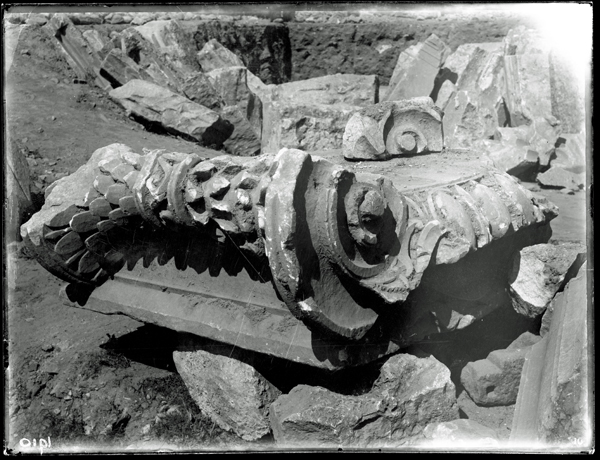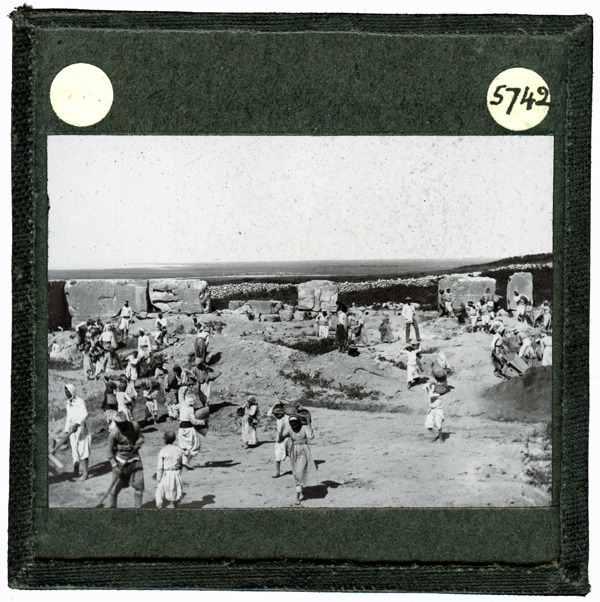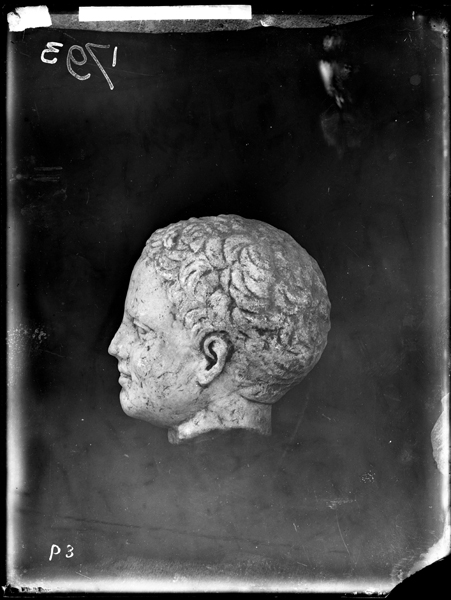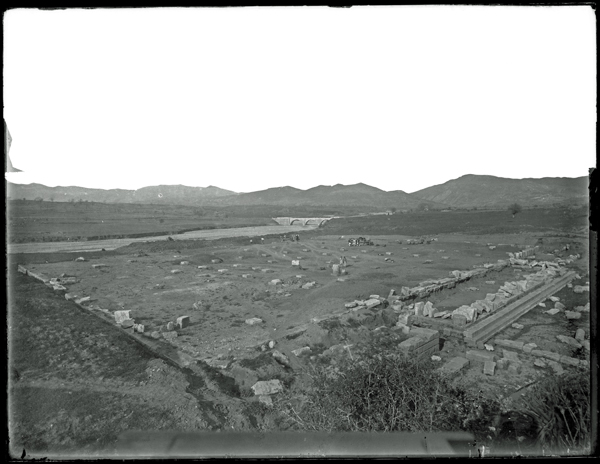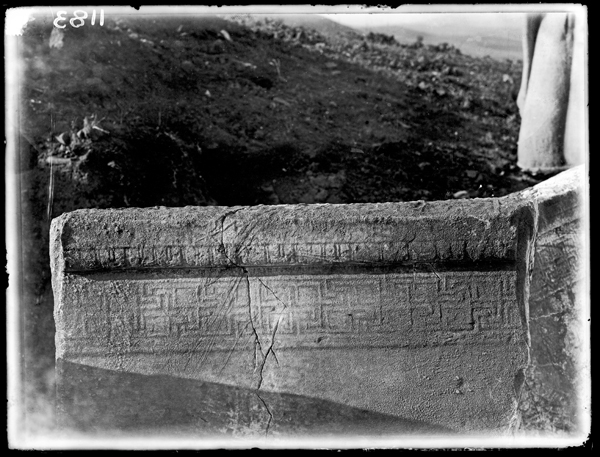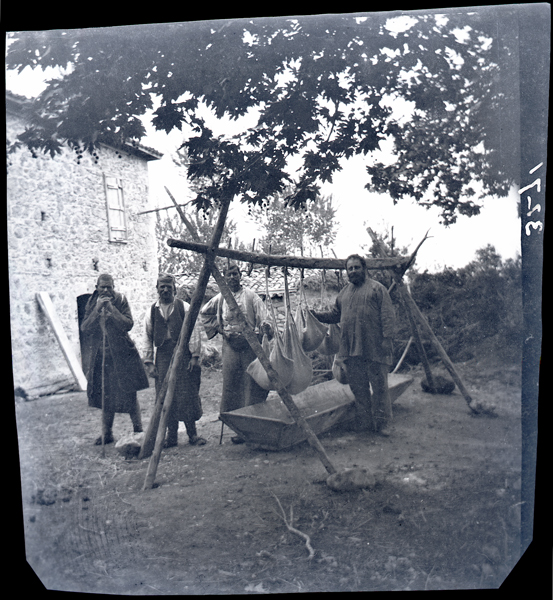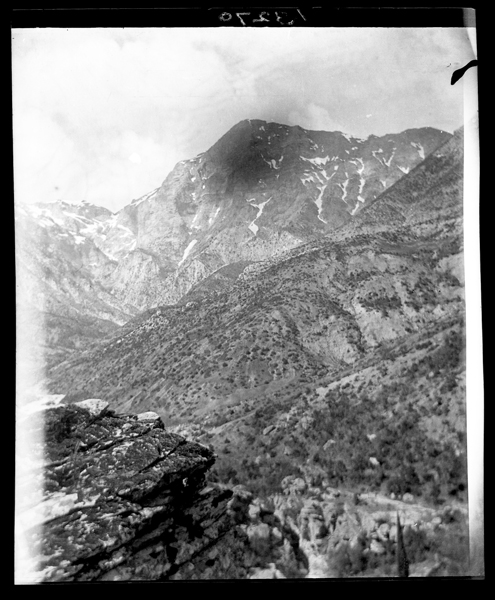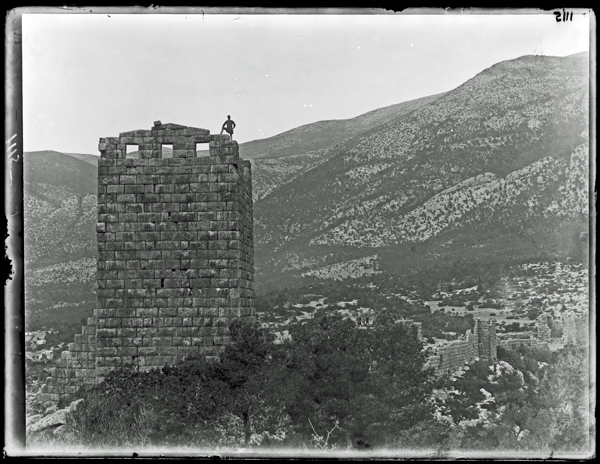Digging I: the Earliest 19th-century BSA Excavations in the BSA SPHS Image Collection
In the early years of the British School at Athens, the annual reports repeatedly remark on its precarious financial situation, dependant on a limited number of grants and subscriptions. However, during these early years, the BSA managed to carry out a number of excavations which were, out of financial necessity, small and often short-term. The earliest documented BSA excavations were at the Olympieion (Athens) 1887; Paphos-Kouklia, Polis tes Chrysochou, Limniti and Salamis (Cyprus) 1888-1890; Megalopolis (Arcadia) 1890-1893; Kyparissia (Arcadia) 1893; Aegosthena (West Attica) 1893; and Abae and Hyampolis (Phocis) 1894.
Most of our information comes from published accounts, primarily in The Journal of Hellenic Studies (JHS) since the Annual of the British School at Athens did not begin publication until 1894. Descriptions of these earliest excavations in the Annual Repots and official histories of the BSA tend to be brief and incomplete. Since it was common practice at the time for the BSA and its members to deposit negatives with the Society for the Promotion of Hellenic Studies (SPHS), extant images from the excavations supplement our knowledge. A handful of images in the BSA SPHS Image collection survive from the excavations at Paphos-Kouklia, Megalopolis, Kyparissa, and Aegosthena. Other images in the collection complement these, although they are not specifically of the excavations.
The first BSA excavation was at the Temple of Olympian Zeus (the Olympieion) in Athens, described in the annual report for 1887, less than a year after the BSA’s foundation. Francis Penrose, the first director, briefly excavated around the temple in order to determine its architectural layout. It was financed by the Society of Dilettanti and published in the following year by the Society. One photograph in the BSA SPHS Image collection of a capital from the Olympieon was probably taken shortly after the excavation. It was photographed by R. Elsey Smith ca. 1887-1888 while he was an architectural student at the BSA.
Ernest A. Gardner (who succeeded Penrose as BSA director) began excavations in Cyprus in 1888, funded by the Cyprus Exploration Fund. The Fund was formed by Oxford and Cambridge universities, the SPHS, and private subscribers. A total of £150 was raised in 1888 and supplemented in 1889 with an additional £150. Only a few images survive in the BSA SPHS Image collection from the excavation at Paphos-Kouklia in 1888 and none for the associated excavations at Leondari and Amargetti conducted respectively by students M.R. James and D.G. Hogarth in the same year. Malcom Macmillan and Louis Dyer who had accompanied E.A. Gardner to Cyprus in 1888 photographed a sculpted head at Paphos which was published in the JHS report. The architect, R. Elsey Smith was also involved with the excavation. Images by Malcolm Macmillan, Louis Dyer and R. Elsey Smith, part of a previous Archive Story, Rule II: The Origins of the SPHS Photographic Collection, included many of Cypriot monuments taken at this time.
No images were deposited with the SPHS for the 1889 excavations at Polis tes Chrysochou and Limniti. Gardner indicated in his director’s report that the results from these two sites were not as spectacular as the previous year’s finds at Paphos. Excavations continued in Cyprus in 1890 after additional funds were secured. Students returned to excavate at Salamis and the tombs at Polis tes Chrysochou. However, by then the BSA’s primary focus had turned to Megalopolis in Arcadia.
The excavation at Megalopolis was conducted over the years 1890-1893. The total funds raised were over £400, placed in a special Megalopolis Fund. Donors listed in the 1890-1891 annual report included private individuals such as Lord Savile, Walter Leaf, Alexander and George Macmillan, as well as the Fitzwilliam Museum Syndicate in Cambridge. Excavation was extensive and included the Thersileion, the Theatre, and various structures in the Agora. Gardner remarked that Megalopolis has ‘proved expensive and laborious to work’ due primarily to a large workforce and the necessity of digging a canal to drain the theatre.
Numerous images from the excavation were donated to the SPHS, and many of them are listed in the first (1897) and second (1904) slide catalogues. The slides had intriguing captions such as ‘Holiday Dress of Workmen’, ‘Excavation in Progress’, ‘Market Place’ and ‘Greek Ploughs’. However, they do not appear in the next comprehensive catalogue of 1913, but are replaced with plans, architectural studies and generally un-peopled views of the site, most of which came from Walter Leaf’s visit in 1891 (mentioned in Rule II: The Origins of the SPHS Photographic Collection). One image of the Thersileion by E.A. Gardner and several from Walter Leaf are the images that survive in the BSA SPHS collection.
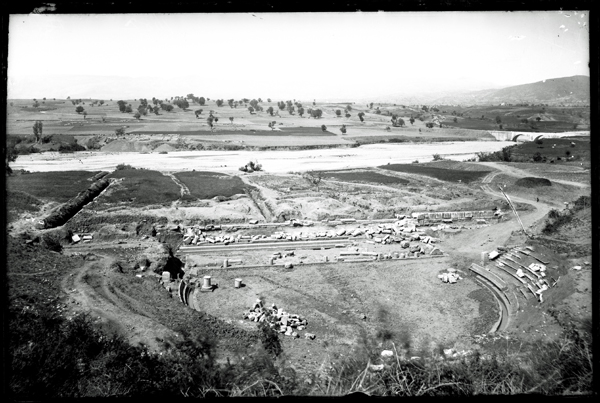
BSA SPHS 01/0369.1682. Megalopolis: Theatre from the top of Cavea looking N. by Walter Leaf, published as fig. 1, pl. II in Excavations at Megalopolis 1892.
Nearing the conclusion of the excavations at Megalopolis in 1893, Gardner, along with two BSA students (A.G. Bather and V.W. Yorke), explored sites in Arcadia that had potential for future excavation. Bather and Yorke conducted test excavations – at their own expense – at two sites near Kyparissia in Arcadia (thought to be ancient Basilis and Bathos). One photograph by E.A. Gardner survives in the BSA SPHS collection from the excavation near Kyparissia: an elaborate stone carved meander. Two other additional photographs below were taken by Gardner during this exploratory expedition in Arcadia.
In the same year, the BSA also conducted a trial excavation at Aegosthena on the Eastern end of the Corinthian Gulf. The primary aim of work at Aegosthena was to map and photograph the well-preserved walls and towers, described as a ‘remarkable example of Greek military architecture of the fourth century’, and to excavate areas of the ancient town. Since the village of Aegosthena (Porto Germeno) was uninhabited at the time, the excavators lived on site in tents lent by the Greek government. According to the financial accounts, a total of £21 and 9 shillings was donated for the survey and excavation.
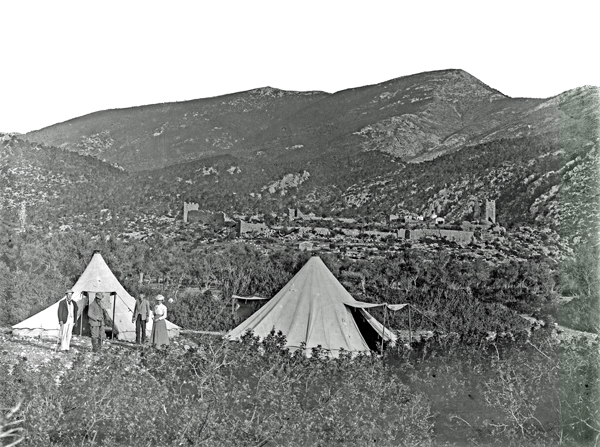
BSA SPHS 01/1566.4007. General view of Aegosthena from N.W. with Professor Gardner’s camp in foreground.
The following year (1894) saw brief excavations at Abae and Hyampolis in Phocis. The excavation was conducted in bad weather and proved disappointing. The temenos of the Temple of Apollo was uncovered and a few fragments of Roman sculpture, inscriptions and other items were discovered at Abae and more inscriptions at Hyampolis. The results were published in JHS in 1896 by Vincent Yorke. There is no mention of the source of funding in the BSA annual report, but the financial records indicate that £54 and 6 shillings were spent on the excavation. Additionally, no images from either Abae or Hyampolis appeared in the SPHS negative register.
In his director’s report for the 1894-95 session, Gardner indicated that due to lack of funds, the BSA was not able to provide many of the students who came to the BSA that year with the valuable experience of archaeological excavation. However, he saw compensation that a few school students participated in excavations in Alexandria under the direction of former BSA student D.G. Hogarth on behalf of the Egyptian Exploration Fund. Nonetheless, Gardner was confident that the prospects for excavation by the BSA would improve in future.
In the 6th edition of Murray’s Handbook to Greece (1896), it was thought necessary to explain why the British School at Athens did not excavate many high-profile archaeological sites or invest in long term strategies like its fellow foreign schools. Funding was cited as the cause.
In explanation of the comparatively subordinate part thus taken by our countrymen in archaeological research upon sites of such consummate interest, it should be mentioned that whereas the French School of Athens enjoys an income of more than £3,000, and the German School one of £2,000 – both being supplemented by special grants – while the American School is supported by the various Universities and Colleges of the United States to the extent of £1,400 a year, the average income of the British School has hitherto been only £400. With such a sum of money at its command, although it must be admitted that the School has made the most of its opportunities, excavation to any considerable extent was manifestly impossible. Assistance, however, has been promised by the Government.
Indeed, the British government did promise monetary assistance to the BSA in 1895, reported in the 1895/1896 BSA Annual Report. The report indicated that the government grant of £500 per annum (for five years) was then before the House of Commons. The grant was duly ratified and reported in the following year’s annual report. More ambitious excavations could now be planned, but that task that would fall to the next director, Cecil Smith.
For a continuation of this story, see Digging II: 19th-century Kynosarges and the Melos Campaign in the BSA SPHS Image Collection.
Deborah Harlan
Honorary Research Fellow
Department of Archaeology
Sheffield University
The archives of 19th-century BSA excavations are now available on the BSA’s Digital Collections.
Click here for more BSA Archive Stories.
Further Reading:
| Olympieion | |
| 1888 | Penrose, F.C. An Investigation of the Principles of Athenian Architecture. London: Society of Dilettanti. |
| Cyprus | |
| 1888 | Hogarth, D.G., M. R. James, R. Elsey Smith and E. A. Gardner ‘Excavations in Cyprus, 1887-88. Paphos, Leontari, Amargetti’ JHS 9: 147-271. |
| 1890 | Munro, J.A.R. and H.A. Tubbs ‘Excavations in Cyprus, 1889. Second Season’s Work. Polis tes Chrysochou.-Limniti’, JHS 11: 1-99. |
| 1891 | Munro, J.A.R. and H.A. Tubbs and W. Wroth ‘Excavations in Cyprus, 1890. Third Season’s Work. Salamis’, JHS 12: 59-198. |
| 1891 | Munro, J.A.R. ‘Excavations in Cyprus. Third Season’s Work-Polis tes Chrysochou’ JHS 12: 298-333. |
| Megalopolis | |
| 1892 | Gardner, E.A. et al. Excavations at Megalopolis, 1890-1891. London: Society for the Promotion of Hellenic Studies suppl. vol. 1 |
| 1892/1893 | Benson, E.F. ‘The Thersilion at Megalopolis’, JHS 13: 319-327. |
| 1892/1893 | Bather, A.G. ‘The Development of the Plan of the Thersilion’ JHS 13: 328-337. |
| 1892/1893 | Loring, W. ‘The Theatre at Megalopolis’ JHS 13: 356-358. Gardner, E.A. 1894. ‘Note on Megalopolis’, JHS 14: 242-243. |
| Kyparissa (Arcadia) | |
| 1892/1893 | Bather, A.G. and V.W. Yorke ‘Excavations on the Probable Sites of Basilis and Bathos’ JHS, 13: 227-231. |
| Aegosthena | |
| 1895 | Benson, E.F. ‘Aegosthena’ JHS 15: 314-324. |
| Abae and Hyampolis | |
| 1896 | Yorke, V.W. ‘Excavations at Abae and Hyampolis in Phocis’ JHS 16: 291-312. |
